战略管理课件英文版-(1)
合集下载
战略管理_英文课件 Ch3_The Internal Organization
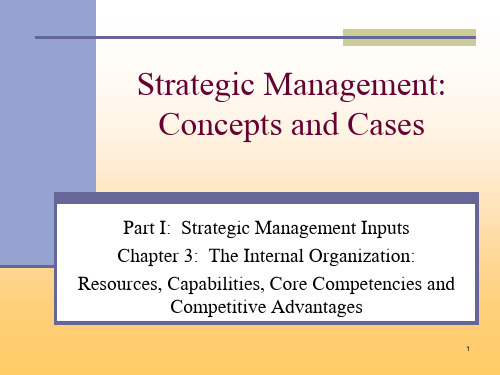
3
Analyzing the Internal Organization (IO)
Context of Internal Analysis
(Cont’d)
Creating Value Exploit core competencies or competitive advantage Value: measured by a product's performance characteristics and by its attributes for which customers are willing to pay The Challenge of Analyzing the IO
Strategic Management: Concepts and Cases
Part I: Strategic Management Inputs Chapter 3: The Internal Organization: Resources, Capabilities, Core Competencies and Competitive Advantages
Involves identifying, developing, deploying and protecting firms‟ resources, capabilites and core competencies Proprietary technologies Changes in economic and political trends, societal values and shifts in customer demands Environment – increases complexity Due to decisions about core competencies and how to nurture them
战略管理英文课件 (1)
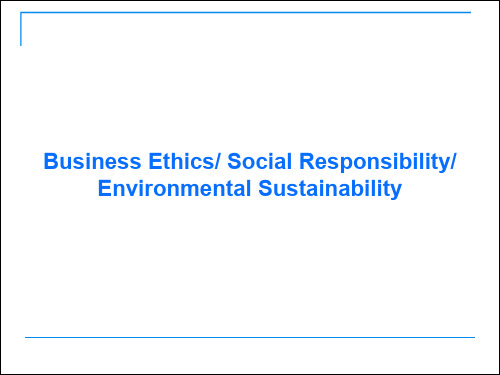
n Environmental strategies could include
q Developing or acquiring green businesses
q Divesting or altering environment-damaging businesses
q Striving to become a low-cost producer through waste minimization and energy conservation
n New “clean technology” business start ups
q Solar q Wind q Biofuels q Insulation
Managing Environmental Affairs in the Firm
n Managers must formulate strategies that preserve and conserve natural resources and control pollution
Environmental Sustainability
n The extent that an organization’s operations and actions protect, mend, and preserve rather than harm or destroy the natural environment
the auto industry n Companies are replacing gasoline powered
vehicles with hybrid electric-natural gas vehicles
March 2009 Copenhagen Meeting
q Developing or acquiring green businesses
q Divesting or altering environment-damaging businesses
q Striving to become a low-cost producer through waste minimization and energy conservation
n New “clean technology” business start ups
q Solar q Wind q Biofuels q Insulation
Managing Environmental Affairs in the Firm
n Managers must formulate strategies that preserve and conserve natural resources and control pollution
Environmental Sustainability
n The extent that an organization’s operations and actions protect, mend, and preserve rather than harm or destroy the natural environment
the auto industry n Companies are replacing gasoline powered
vehicles with hybrid electric-natural gas vehicles
March 2009 Copenhagen Meeting
战略管理英文版最新版教学ppt课件第1章

What Is Strategy and Why Is It Important?
Part 1 Strategy Analysis 1-2
LO 1-1 Define competitive advantage, sustainable competitive advantage, competitive disadvantage, and competitive parity.
LO 1-7 Critically evaluate the role that different stakeholders play in the firm’s quest for competitive advantage.
1-8
EXHIBIT 1.1 Industry, Firm, and Other Effects Explaining Superior Firm Performance
❖ Yahoo buys Overture for its own search product
• Microsoft launches its own search in 2009
➢ Bing now partnered with Yahoo
1-4
Microsoft and Google – Online Search
• What’s happening in our chapter opener?
➢ Why might Microsoft have acted the way it did?
➢ If they had not killed Keywords, would Microsoft have beat Google to search and linked ads?
Part 1 Strategy Analysis 1-2
LO 1-1 Define competitive advantage, sustainable competitive advantage, competitive disadvantage, and competitive parity.
LO 1-7 Critically evaluate the role that different stakeholders play in the firm’s quest for competitive advantage.
1-8
EXHIBIT 1.1 Industry, Firm, and Other Effects Explaining Superior Firm Performance
❖ Yahoo buys Overture for its own search product
• Microsoft launches its own search in 2009
➢ Bing now partnered with Yahoo
1-4
Microsoft and Google – Online Search
• What’s happening in our chapter opener?
➢ Why might Microsoft have acted the way it did?
➢ If they had not killed Keywords, would Microsoft have beat Google to search and linked ads?
林奇《战略管理》(英文版第7版)教学课件_pp08
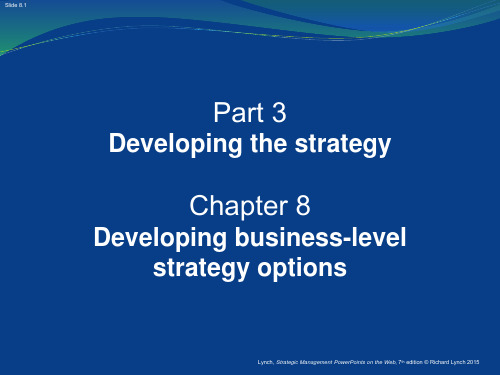
Keep points short and well-argued Concentrate only on the key issues: no long lists Use key factors for success (KFS) as a guide
Lynch, Strategic Management PowerPoints on the Web, 7th edition © Richard Lynch 2015
Options can be combined together to give four options in total: four generic strategies for any organisation
Lynch, Strategic Management PowerPoints on the Web, 7th edition © Richard Lynch 2015
Slide 8.6 Lynch, Strategic Management PowerPoints on the Web, 7th edition © Richard Lynch 2015
Slide 8.7
Options based on market opportunities - 1
In the 1980s, Professor Michael Porter argued that there were only four fundamental strategic options available to all companies: Porter’s Generic Strategy Options
Environment
Options
This session
Lynch, Strategic Management PowerPoints on the Web, 7th edition © Richard Lynch 2015
Options can be combined together to give four options in total: four generic strategies for any organisation
Lynch, Strategic Management PowerPoints on the Web, 7th edition © Richard Lynch 2015
Slide 8.6 Lynch, Strategic Management PowerPoints on the Web, 7th edition © Richard Lynch 2015
Slide 8.7
Options based on market opportunities - 1
In the 1980s, Professor Michael Porter argued that there were only four fundamental strategic options available to all companies: Porter’s Generic Strategy Options
Environment
Options
This session
战略管理(中英文)
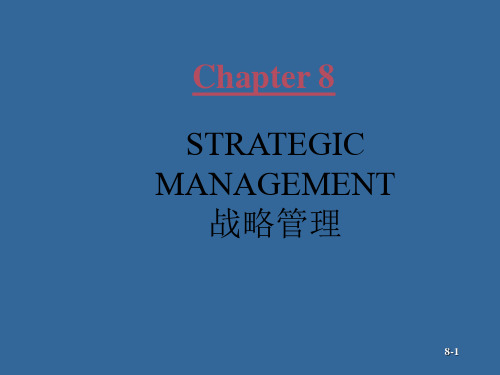
The Strategic Management Process
8-5
© Prentice Hall, 2002
8 6
The Strategic Management Process
1. Identifying the Organization’s Current Mission, Objectives, and Strategies确定组织当前的宗旨、 目标和战略 – Mission宗旨 - statement of the purpose of an organization组织的目的陈述 • important in profit and not-for-profit organizations在盈利性和非盈利性组织中都 很重要。 • important to identify the goals currently in place and the strategies currently being pursued 确定当前的目标和当前追求的战略是非常重 要的。
8-3
The Importance Of Strategic Management 战略管理的重要性
What Is Strategic Management什么是战略管理?
– A set of managerial decisions and actions that determines the longrun performance of an organization一个组织从全局出发而
8-12
The Strategic Management Process (cont.)
6. Formulating Strategies制定战略 – require strategies at the corporate, business, and functional levels of the organization 战略需要在公司层、事业层和职能层设立 – strategy formulation follows the decision-making process 指定战略应遵循决策程序 7. Implementing Strategies实施战略 – a strategy is only as good as its implementation 无论战略计划制定得多么有效,如果不能恰当地实施 仍不会成功 8. Evaluating Results评价结果 – control process to determine the effectiveness of a strategy 控制过程决定一个战略的效果
战略管理英文版最新版教学ppt课件第2章

• PRODUCT-ORIENTED MISSIONS • Define the firm in terms of products or services
➢ U.S. Railroads: "Safest… N. American railroad”
❖ Missed the chance to move into delivery before UPS & Federal Express
➢ Delight our customers, employees, and shareholders by relentlessly delivering the platform and technology advancements that become essential to the way we work and live
LO 2-4 Critically evaluate the relationship between mission statements and competitive advantage.
LO 2-5 Explain why anchoring a firm in ethical values is essential for long-term success.
LO 2-6 Compare and contrast strategic planning, scenario planning, and strategy as planned emergence, and discuss strategic implications.
2-3
ChapterCase 2 Teach For America: Inspiring Future Leaders • TFA Mission: Eliminate educational inequality
➢ U.S. Railroads: "Safest… N. American railroad”
❖ Missed the chance to move into delivery before UPS & Federal Express
➢ Delight our customers, employees, and shareholders by relentlessly delivering the platform and technology advancements that become essential to the way we work and live
LO 2-4 Critically evaluate the relationship between mission statements and competitive advantage.
LO 2-5 Explain why anchoring a firm in ethical values is essential for long-term success.
LO 2-6 Compare and contrast strategic planning, scenario planning, and strategy as planned emergence, and discuss strategic implications.
2-3
ChapterCase 2 Teach For America: Inspiring Future Leaders • TFA Mission: Eliminate educational inequality
战略管理英文课件-(1)精选全文

Natural Environment
Developing a Strategy
Supportive Culture
Adapting Production/ Operations Processes
Developing HR
Function
If Necessary Downsizing
Management Issues & Strategy Implementation
Positioning forces before the Managing forces during the
action
action
Focuses on effectiveness
Focuses on efficiency
Primarily an intellectual process
Requires good intuitive and analytical skills
• Sets expectations for managers and employees
• Basis for management control and coordination
Management Issues & Strategy Implementation
Allocating Resources
Human Resources Concerns
• Assessing staffing needs and costs
• Develop performance incentives
• ESOPs • Child-care policies • Work-life balance
Important Implementation Concerns
Developing a Strategy
Supportive Culture
Adapting Production/ Operations Processes
Developing HR
Function
If Necessary Downsizing
Management Issues & Strategy Implementation
Positioning forces before the Managing forces during the
action
action
Focuses on effectiveness
Focuses on efficiency
Primarily an intellectual process
Requires good intuitive and analytical skills
• Sets expectations for managers and employees
• Basis for management control and coordination
Management Issues & Strategy Implementation
Allocating Resources
Human Resources Concerns
• Assessing staffing needs and costs
• Develop performance incentives
• ESOPs • Child-care policies • Work-life balance
Important Implementation Concerns
战略管理课件英文版
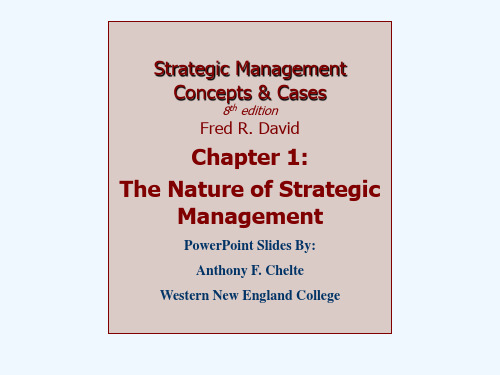
Organizing Themes
• Global considerations impact virtually all strategic decisions.
• E-commerce has become a vital strategic management tool.
• The natural environment has become an important strategic issue.
▪ Widely viewed as panacea for problems
Brief History
• 1980s
➢ Strategic planning cast aside
▪ Planning models did not yield higher returns
• 1990s–2000
➢ Revival of strategic planning
• Strategic planning
➢Refers to:
▪ Strategy formulation
Brief History
• 1950s
➢ Term strategic planning originates
1960s – 1970s ➢ Strategic planning very popular
1. Strategists 2. Vision statements 3. Mission statements 4. External opportunities and threats 5. Internal strengths and weaknesses
Key Strategic Management Terms (Cont’d)
戴维 战略管理(第17版)全套英文教辅教学课件david _sm17_ppt_01
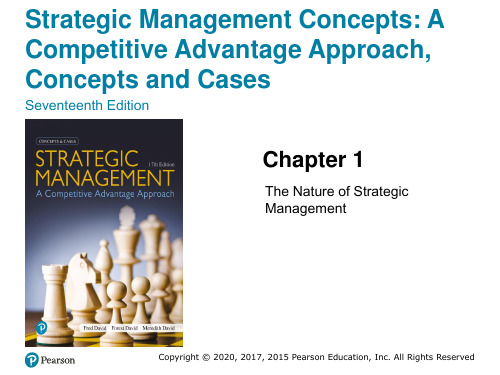
Copyright © 2020, 2017, 2015 Pearson Education, Inc. All Rights Reserved
Defining Strategic Management (1 of 3)
Strategic Management • The art and science of formulating, implementing, and
Copyright © 2020, 2017, 2015 Pearson Education, Inc. All Rights Reserved
Learning Objectives (2 of 2)
1.5 Describe the benefits of engaging in strategic management. 1.6 Explain why some firms do not engage in strategic planning. 1.7 Describe the pitfalls in doing strategic planning. 1.8 Discuss the connection between business and military strategy. 1.9 Explain how this course can enhance a student’s employability.
(2 of 6)
• Strategists – Individuals most responsible for the success or failure of an organization – Help an organization gather, analyze, and organize information
Defining Strategic Management (1 of 3)
Strategic Management • The art and science of formulating, implementing, and
Copyright © 2020, 2017, 2015 Pearson Education, Inc. All Rights Reserved
Learning Objectives (2 of 2)
1.5 Describe the benefits of engaging in strategic management. 1.6 Explain why some firms do not engage in strategic planning. 1.7 Describe the pitfalls in doing strategic planning. 1.8 Discuss the connection between business and military strategy. 1.9 Explain how this course can enhance a student’s employability.
(2 of 6)
• Strategists – Individuals most responsible for the success or failure of an organization – Help an organization gather, analyze, and organize information
战略管理培训课件(PPT 85张)
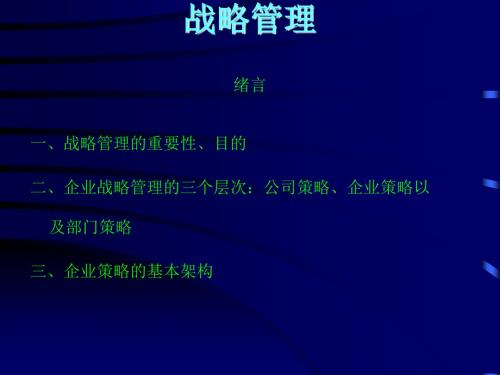
IBM 利用本身市场权力来增强它在市场的竞争 能力.下面例子是从IBM跟美国政府反托拉斯法诉 讼中泄露出来的.美国政府控告IBM有下列违反反
托拉斯法的行为:
1、提前宣布新产品的推出 2、捆束策略
3、主机价格高,周边设备价格低
4、拒绝维护采取其它品牌周边设备以及软件的
IBM主机
5、免费训练使用者 6、进行价格歧视,对于教育机构,价格比较低 7、如果目前使用者计划要转换到别的 机种,IBM 拒绝展延它的契约
现 有 产 业 利 润 进入阻绝策略
进入成本
+
退出成本
进入后利润
现有厂商的报复
厂 商 的 数 目
资 产 特 定 性
名 声 效 果
策 略 的 重 要 性
•经济规模 •资产特定性 •已有合约 •投资 •学习成本 •使用者转换成本 •产品空间 •先进品牌优势 •专利 (结构性的进入障碍)
二、进入决策
• 进入成本是厂商为了要达到和目前竞争 者具有相同地位所需要的成本 • 影响进入成本的因素:
竞争
价格竞争 是否阻绝新厂商进入 NO
市场权力
YES 进入阻绝策略 1、限制定价 2、超额设备 3、品牌扩散 4、提高对手成本 YES
NO
口号管理
首 动 利 益
产 品 定 位
空 间 竞 争
价 格 歧 视
计 划 性 落 伍
四、决定合作或竞争的因素
1、厂商的数目 2、成本结构 3、产业需求成长率
4、产品的同质性
• BCG的问题: 从理论上而言: (1)BCG并不是一个利润极大化的方式; (2)市场占有率与利润率的关系并不非常固定; (3)BCG并不重视综效 (4)举债方式筹措资金并不在BCG的考虑之中 执行上的问题: (1)实行BCG方式时要进行SBU(策略事业部) 重组,这要遭到许多组织的阻力; (2)由于不考虑综效,很难处理各个SBU之间的 关系; (待续)
林奇《战略管理》(英文版第7版)教学课件_pp14
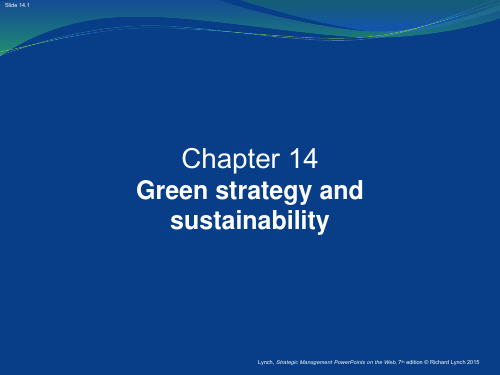
for change
Sources: Hart, S (1997) ‘Beyond Greening: Strategies for a Sustainable World’, Harvard Business Review, Reprint 97105, accessed free on the web courtesy of Vestas; Elkington, J (1994) ‘Towards the sustainable corporation: Winwin-win business strategies’, California Management Review, Winter, Vol 36, No 2, p90; Unruh, G and Ettenson, R (2010) ‘Growing Green’, Harvard Business Review, June; Unruh, G and Ettenson, R (2010) ‘Winning in the Green Frenzy’, Harvard Business Review, November.
Emergent outlook on
benefits and costs
•Changing customer attitudes and tastes •Further new technologies market opportunities and costs •Costs of energy price changes, supply issues
electrification Sustainable use of natural resources Protection of the biosphere and development of
Sources: Hart, S (1997) ‘Beyond Greening: Strategies for a Sustainable World’, Harvard Business Review, Reprint 97105, accessed free on the web courtesy of Vestas; Elkington, J (1994) ‘Towards the sustainable corporation: Winwin-win business strategies’, California Management Review, Winter, Vol 36, No 2, p90; Unruh, G and Ettenson, R (2010) ‘Growing Green’, Harvard Business Review, June; Unruh, G and Ettenson, R (2010) ‘Winning in the Green Frenzy’, Harvard Business Review, November.
Emergent outlook on
benefits and costs
•Changing customer attitudes and tastes •Further new technologies market opportunities and costs •Costs of energy price changes, supply issues
electrification Sustainable use of natural resources Protection of the biosphere and development of
战略管理英文课件 (1)
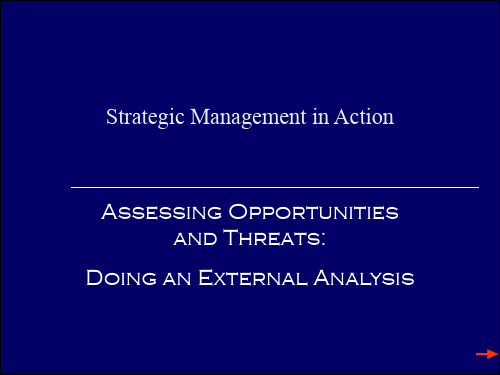
Strategic Management in Action
Assessing Opportunities and Threats:
Doing an External Analysis
Learning Objectives
1. Differentiate between external environmental opportunities and threats.
• Organizations function as systems (Barnard, 1938) • Affect and impact environment
Organizations as Open Systems
Environment
Organization as an Open System
• Environmental stability
Amount of change occurring in an organization’s environment Dynamic (rapid) versus Stable (minimal or slow)
• Environmental complexity
(continued on next slide)
Learning Objectives
n 6.
Describe the components in an organization’s
general environment.
7. Discuss what types of information on the external environment a strategic manager needs and where he or she might find this information.
Assessing Opportunities and Threats:
Doing an External Analysis
Learning Objectives
1. Differentiate between external environmental opportunities and threats.
• Organizations function as systems (Barnard, 1938) • Affect and impact environment
Organizations as Open Systems
Environment
Organization as an Open System
• Environmental stability
Amount of change occurring in an organization’s environment Dynamic (rapid) versus Stable (minimal or slow)
• Environmental complexity
(continued on next slide)
Learning Objectives
n 6.
Describe the components in an organization’s
general environment.
7. Discuss what types of information on the external environment a strategic manager needs and where he or she might find this information.
战略管理流程讲义(英文版!03资料

VALUE for customers?
And... Will environmental changes make our core competencies obsolete?
Are substitutes available for our core competencies?
Are our core competencies easily imitated?
such as capital equipment, skills of employees, brand names, finances and talented managers
Ch3-8
Resources
What a firm Has...
What a firm has to work with: its assets, including its people and the value of its brand name
Ch3-5
Discovering Core Competencies
Resources
* Tangible * Intangible
Ch3-6
ResouБайду номын сангаасces
What a firm Has...
What a firm has to work with:
its assets, including its people and the value of its brand name
* Financial * Physical * Technological * Organizational
Intangible Resources
* Valuable * Rare * Costly to Imitate * Nonsubstitutable
And... Will environmental changes make our core competencies obsolete?
Are substitutes available for our core competencies?
Are our core competencies easily imitated?
such as capital equipment, skills of employees, brand names, finances and talented managers
Ch3-8
Resources
What a firm Has...
What a firm has to work with: its assets, including its people and the value of its brand name
Ch3-5
Discovering Core Competencies
Resources
* Tangible * Intangible
Ch3-6
ResouБайду номын сангаасces
What a firm Has...
What a firm has to work with:
its assets, including its people and the value of its brand name
* Financial * Physical * Technological * Organizational
Intangible Resources
* Valuable * Rare * Costly to Imitate * Nonsubstitutable
战略管理(英文)
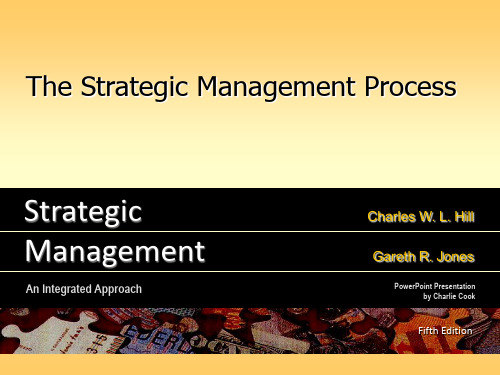
17
Strategy As an Emergent Process
Strategy making in an unpredictable world
❖ Creates the necessity for flexible strategic approaches.
Strategy making by lower-level managers
Engagement, explanation, and expectations
Planning for the present: Strategic Intent
❖ Recognition of the static nature of the strategic fit model. ❖ Strategic intent in focusing the organization on winning by
Success requires adapting strategy and structure to a changing world.
The feedback loop in strateБайду номын сангаасic planning.
Corporate
Operational
Business
Functional
14
Strategic Managers
Planning under uncertainty
❖ Scenario planning for dynamic environmental change
Ivory tower planning
❖ Lack of contact with operational realities ❖ The importance of involving operating managers ❖ Procedural justice in the decision-making process
Strategy As an Emergent Process
Strategy making in an unpredictable world
❖ Creates the necessity for flexible strategic approaches.
Strategy making by lower-level managers
Engagement, explanation, and expectations
Planning for the present: Strategic Intent
❖ Recognition of the static nature of the strategic fit model. ❖ Strategic intent in focusing the organization on winning by
Success requires adapting strategy and structure to a changing world.
The feedback loop in strateБайду номын сангаасic planning.
Corporate
Operational
Business
Functional
14
Strategic Managers
Planning under uncertainty
❖ Scenario planning for dynamic environmental change
Ivory tower planning
❖ Lack of contact with operational realities ❖ The importance of involving operating managers ❖ Procedural justice in the decision-making process
战略管理理论(英文)

Follow this Learning Outline as you read and study this chapter.
The Importance of Strategic Management
ØDefine strategic management, strategy, and business model.
8–11
Strategic Management Process (cont’d)
• Step 3: Doing an internal analysis
➢ Assessing organizational resources, capabilities, and activities:
❖ Strengths create value for the customer and strengthen the competitive position of the firm.
ØExplain why strategic management is important.
The Strategic Management Process
ØList the six steps in the strategic management process. ØDescribe what managers do during external and internal
➢ Goals: the foundation for further planning
❖ Measurable performance targets
• Step 2: Doing an external analysis
➢ The environmental scanning of specific and general environments
The Importance of Strategic Management
ØDefine strategic management, strategy, and business model.
8–11
Strategic Management Process (cont’d)
• Step 3: Doing an internal analysis
➢ Assessing organizational resources, capabilities, and activities:
❖ Strengths create value for the customer and strengthen the competitive position of the firm.
ØExplain why strategic management is important.
The Strategic Management Process
ØList the six steps in the strategic management process. ØDescribe what managers do during external and internal
➢ Goals: the foundation for further planning
❖ Measurable performance targets
• Step 2: Doing an external analysis
➢ The environmental scanning of specific and general environments
Strategic Management(战略管理-中英文)
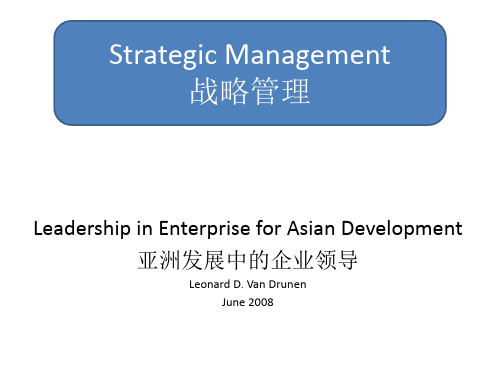
Environments: 环境 •Internal内部 •External 外部
Competing via 竞争方 式…
Rivalry: 竞争 •Business level strategies 经营层次战略 •Multiproduct strategies 产品多元化战略 •Mergers & acquisitions 并购
Competing via 竞争方 式…
Rivalry: 竞争 •Business level strategies 经营层次战略 •Multiproduct strategies 产品多元化战略 •Mergers & acquisitions 并购
Market entry: 市场进入 •Across borders 跨国 •Alliances 联盟 •Entrepreneurship 创业
Market entry: 市场进入 •Across borders 跨国 •联盟 •Entrepreneurship 创业
External Environment Analysis 外部环境分 析
Potential Entrants 潜在竞争 对手 General Environment 总体环境
机动性增加,风险降低,资本需求降低 Allows the firm to focus on its core competencies. 发展核心竞争 力
Potential problems with outsourcing: 外包可能产生的问题 Job losses for the firm’s communities. 企业岗位减少 Hard to reverse outsourcing decisions. 外包决策难以收回
- 1、下载文档前请自行甄别文档内容的完整性,平台不提供额外的编辑、内容补充、找答案等附加服务。
- 2、"仅部分预览"的文档,不可在线预览部分如存在完整性等问题,可反馈申请退款(可完整预览的文档不适用该条件!)。
- 3、如文档侵犯您的权益,请联系客服反馈,我们会尽快为您处理(人工客服工作时间:9:00-18:30)。
Strategic Management Concepts & Cases
8th edition
Fred R. David
Chapter 1:
The Nature of Strategic Management
PowerPoint Slides By:
Anthony F. Chelte
Western New England College
▪ Strategy formulation
*© 2001 Prentice Hall
Ch. 1-6
Brief History
• 1950s
➢ Term strategic planning originates
1960s – 1970s ➢ Strategic planning very popular
1. Strategists 2. Vision statements 3. Mission statements 4. External opportunities and threats 5. Internal strengths and weaknesses
*© 2001 Prentice Hall
• The natural environment has become an important strategic issue.
*© 2001 Prentice Hall
Ch. 1-2
Strategic Management Defined
Art and science of formulating, implementing, and evaluating crossfunctional decisions that enable an organization to achieve its objectives.
Ch. 1-13
Key Strategic Management Terms (Cont’d)
6. Long-term objectives 7. Strategies 8. Annual objectives 9. Policies
*© 2001 Prentice Hall
Ch. 1-14
Strategic Management Terms (Cont’d)
Ch. 1-5
Terminology
• Strategic management
➢Refers to:
▪ Strategy formulation ▪ Strategy implementation ▪ Strategy evaluation
• Strategic planning
➢Refers to:
• 1990s–2000
➢ Revival of strategic planning
▪ Widely practiced in business world
*© 2001 Prentice Hall
Ch. 1-8
Strategic-Management Process Three Stages
Strategy Formulation
Strategists
• Usually found in high levels of management (CEO)
➢Help organization gather, analyze, and organize information
▪ Widely viewed as panacea for problems
*© 2001 Prentice Hall
Ch. 1-7
Brief History
• 1980s
➢ Strategic planning cast aside
▪ Planning models did not yield higher returns
“Strategic Planning”
• Strategic management
➢ Used more often in academia
• Strategic planning
➢ Used more often in the business world
*© 2001 Prentice Hall
*© 2001 Prentice Hall
Ch. 1-1
Organizing Themes
• Global considerations impact virtually all strategic decisions.
• E-commerce has become a vital strategic management tool.
Strategy Implementation
Strategy Evaluation
*© 2001 Prentice Hallation
Vision & Mission Opportunities & Threats Strengths & Weaknesses
*© 2001 Prentice Hall
Ch. 1-3
Strategic Management Club
Visit and join the club on-line:
*© 2001 Prentice Hall
Ch. 1-4
Terminology
“Strategic Management”
Synonymous with
*© 2001 Prentice Hall
Ch. 1-11
Strategy Evaluation
Review External & Internal Measure Performance Corrective Action
*© 2001 Prentice Hall
Ch. 1-12
Key Strategic Management Terms (Cont’d)
Long-Term Objectives Alternative Strategies
Strategy Selection
*© 2001 Prentice Hall
Ch. 1-10
Strategy Implementation
Annual Objectives Policies
Motivate Employees Resource Allocation
8th edition
Fred R. David
Chapter 1:
The Nature of Strategic Management
PowerPoint Slides By:
Anthony F. Chelte
Western New England College
▪ Strategy formulation
*© 2001 Prentice Hall
Ch. 1-6
Brief History
• 1950s
➢ Term strategic planning originates
1960s – 1970s ➢ Strategic planning very popular
1. Strategists 2. Vision statements 3. Mission statements 4. External opportunities and threats 5. Internal strengths and weaknesses
*© 2001 Prentice Hall
• The natural environment has become an important strategic issue.
*© 2001 Prentice Hall
Ch. 1-2
Strategic Management Defined
Art and science of formulating, implementing, and evaluating crossfunctional decisions that enable an organization to achieve its objectives.
Ch. 1-13
Key Strategic Management Terms (Cont’d)
6. Long-term objectives 7. Strategies 8. Annual objectives 9. Policies
*© 2001 Prentice Hall
Ch. 1-14
Strategic Management Terms (Cont’d)
Ch. 1-5
Terminology
• Strategic management
➢Refers to:
▪ Strategy formulation ▪ Strategy implementation ▪ Strategy evaluation
• Strategic planning
➢Refers to:
• 1990s–2000
➢ Revival of strategic planning
▪ Widely practiced in business world
*© 2001 Prentice Hall
Ch. 1-8
Strategic-Management Process Three Stages
Strategy Formulation
Strategists
• Usually found in high levels of management (CEO)
➢Help organization gather, analyze, and organize information
▪ Widely viewed as panacea for problems
*© 2001 Prentice Hall
Ch. 1-7
Brief History
• 1980s
➢ Strategic planning cast aside
▪ Planning models did not yield higher returns
“Strategic Planning”
• Strategic management
➢ Used more often in academia
• Strategic planning
➢ Used more often in the business world
*© 2001 Prentice Hall
*© 2001 Prentice Hall
Ch. 1-1
Organizing Themes
• Global considerations impact virtually all strategic decisions.
• E-commerce has become a vital strategic management tool.
Strategy Implementation
Strategy Evaluation
*© 2001 Prentice Hallation
Vision & Mission Opportunities & Threats Strengths & Weaknesses
*© 2001 Prentice Hall
Ch. 1-3
Strategic Management Club
Visit and join the club on-line:
*© 2001 Prentice Hall
Ch. 1-4
Terminology
“Strategic Management”
Synonymous with
*© 2001 Prentice Hall
Ch. 1-11
Strategy Evaluation
Review External & Internal Measure Performance Corrective Action
*© 2001 Prentice Hall
Ch. 1-12
Key Strategic Management Terms (Cont’d)
Long-Term Objectives Alternative Strategies
Strategy Selection
*© 2001 Prentice Hall
Ch. 1-10
Strategy Implementation
Annual Objectives Policies
Motivate Employees Resource Allocation
